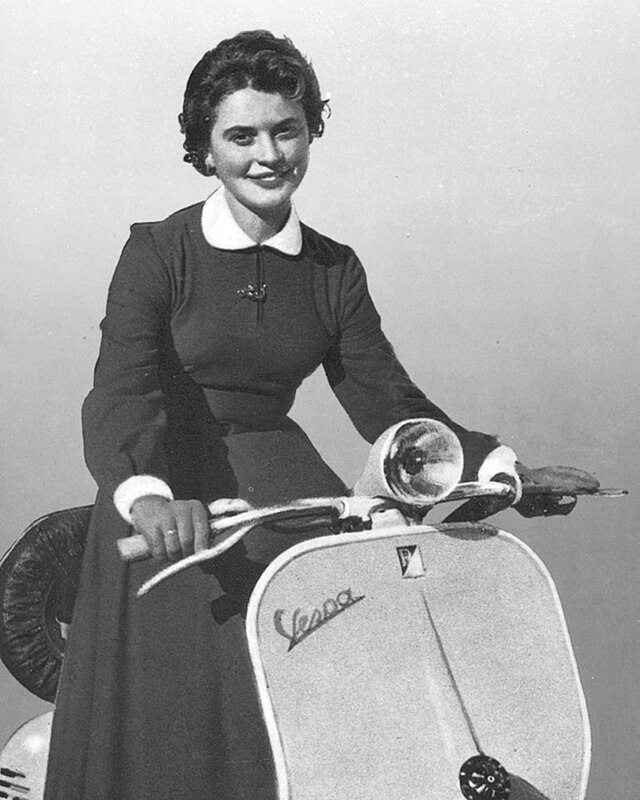Holiness in the Ordinary: The Story of Venerable Carla Ronci
You may have seen a photo of Venerable Carla—a pretty, smiling young woman on a Vespa motorcycle. Venerable Carla Ronci was a young single Catholic laywoman from Italy who greatly loved Jesus. She is remembered yesterday on her birthday for her holiness, kindness, and joy. Carla Ronci was born in the town of Torre Pedrera, […]



You may have seen a photo of Venerable Carla—a pretty, smiling young woman on a Vespa motorcycle. Venerable Carla Ronci was a young single Catholic laywoman from Italy who greatly loved Jesus. She is remembered yesterday on her birthday for her holiness, kindness, and joy.
Carla Ronci was born in the town of Torre Pedrera, Italy on April 11, 1936, to Mario and Jolanda Ronci and was the oldest of their three children. Although she was an excellent student and received the highest grades in her class, she was unable to continue her education after graduating from elementary school, as her parents wanted her to learn to be a tailor and seamstress. As a young teenager, Carla enjoyed going to the movies, dancing, swimming, and reading magazines.
Carla was baptized as a baby and went to confession, received her first Holy Communion, and was confirmed when she was six years old. However, her family was not very religious, and Catholicism was not an important part of her life as a child. When the Ursuline Sisters came to Torre Pedrera to start a kindergarten, Carla observed their faithfulness in attending Mass and their unselfishness in helping the children. The Ursulines eventually became a great influence on her life.
When Carla was fourteen years old, she experienced a conversion. One evening, while looking out the window, she saw a vision of Jesus. She said, “I felt a presence in my heart and an invitation.”1 She regretted the superficial way she had been living, and resolved to go to Mass the next day. She did so and continued to attend Mass afterwards, also resolving to go to confession regularly. She gave up dancing and reading secular magazines. Her parish priest gave her a book of the Gospels, which she read over and over. She joined the Catholic Action organization, which enabled her to study the Church’s teachings in depth. She was appointed a leader of a Catholic Action group for girls. She became friends with the Ursuline Sisters, and she asked her parish priest, Don Napoleone Succi, to be her spiritual director. In 1956, she made the consecration to the Blessed Mother. She also made private vows of chastity and poverty.

After her conversion and throughout her life, Carla volunteered in her parish in many ways: she planned pilgrimages to shrines, bought books for the parish library, did accounting work, taught marriage preparation classes, taught catechism, mentored teenage girls, organized parish festivals, designed costumes, directed and acted in plays for the parish’s drama club, washed altar linens, cleaned the church, visited the sick in the hospital, and donated money to help the poor.
Carla had a great love for Jesus in the Eucharist. She went to Mass and received Holy Communion every day and made a visit to Jesus in her parish church every afternoon. She wrote, “During Communion, I welcome Jesus to let Him live inside of me, for me: Jesus, I want to live with you; you are to show yourself to others through my poor life.”1
Believing she had a vocation to be a nun, Carla joined the Ursuline Sisters as a novice when she was twenty-two years old. Her father was very opposed to her entering religious life, and during her time with the Ursulines, he kept contacting the convent, demanding that Carla return home. After four months, the Mother Superior told Carla that it would be better for her to go home and live a life of holiness as a laywoman. Carla went home and prayed to know God’s will for her, as she still wanted to dedicate her life to Jesus.
Wanting to help girls and young women, Carla opened a sewing workshop at her home where she taught sewing and embroidery skills and also invited the students to pray the Rosary with her. Carla’s cousin, who attended the sewing classes, remembered that during the lessons, the young women talked with Carla about everything going on in their lives, and she gave them advice. Carla also talked to them about the lives of the saints. She tried to be a good role model to the young women and to show them that one could live an ordinary life as a devout Catholic. She said, “I wear the same clothes as my peers, with elegance and modesty, and I try to show souls that being an active Christian is a source of joy, not suffering.”2
While Carla’s life was very busy, she still spent much time in prayer every day. She also prayed while she worked and offered up everything she did to Jesus. Her cousin remembered hearing her pray quietly during the sewing workshop, “For you, Jesus! Jesus, I love you!”
Two years after leaving the Ursulines, Carla learned of a secular institute for women, the Institute of the Handmaids of the Mother of Mercy. The women in this group were consecrated to Jesus, but continued to live in the world. Carla applied to join it on January 6, 1961, and after a time of formation, made her vows in January 1963. In her diary, she wrote “Now the Lord is making my dreams come true by having me consecrate myself in an institute which requires its girls to lead a secular life. My Lord, I thank you for being so good with me.”1 It made Carla very happy to consecrate her life to Jesus and she called Him her “bridegroom.”
Carla came to realize that God’s will was to be found in the circumstances of her life, and that He allowed everything to happen for her sanctification. She wrote in her diary: “Dear soul, complain not: you live where you are to, as God chose this place for you with his infinite wisdom. Here, in this place God has chosen for you, you have the possibility to sanctify yourself: you wouldn’t be able to do it elsewhere. Dear soul, acceptance is not enough. You must be happy and make others happy wherever God may sow, plant, or transplant you. Dear soul, to blossom is to be happy with what is done for you; to be able to give thanks for the tiniest favors; to be happy with having to help others without receiving anything in return; to tell those around you, with a sincere smile on your face and simplicity in your heart ‘I like being with you.’”2 She also wrote: “It doesn’t matter, Jesus, do what you want with me, provided that you are always with me… My task is to bring Jesus to the world.”3
Carla had a great love for the priesthood; she was dedicated to praying for priests and offered up her suffering for them. She also prayed for God to call more men to the vocation of the priesthood. She wrote about the role of the priest: “It is in him that I find truth, it is in him that I find fortitude, it is in him that I find grace. In him I find Jesus above all. These are words that do not intend to enhance the human figure of the priest, who may sometimes not live his mission in an edifying way, but which recall the objective, sacramental foundations of the priestly ministry. The priest, in fact, administers truth, fortitude and grace because he is linked to Christ, pastor and head of his people.” She also wrote: “Lord, I have only this heart of mine full of you, who are the infinite. I offer you this, so that you protect your priests.” At the end of her life, when she was very ill, she wrote to her spiritual director that she was offering her heart and her life for priests, and offered herself as “a victim of reparation for their falls, for their infidelities, for what they do not do and should do, for what they do and should not do…”4
Although Carla never had biological children, she was a devoted spiritual mother to many, including the girls in her Catholic Action group, the children in her parish catechism classes, the girls and young women in her sewing workshop, the priests she prayed for, and the people in her town. She once wrote “understanding the needs of others and being maternally sympathetic is wonderful.”1 She was frequently asked for advice and would often respond by saying, “Tomorrow, I will give you the answer,” then she went to church to pray to Jesus for the person and to ask Him to help her give good advice.
People enjoyed spending time with Carla because she was a very joyful person; the source of her joy was her great love for Jesus. She once wrote, “My heart is so peaceful and joyful, and thinking of Jesus makes me so happy I cannot even explain it.”1
In the summer of 1969, Carla developed liver cancer, and soon afterwards, developed lung cancer as well. In January 21, 1970, she went to stay in a hospital in Bologna operated by the Ursuline Sisters. She was given tests and treatments, but her health did not improve. She continued to write brief entries in her diary while in the hospital, revealing the great physical and emotional suffering she endured, while trusting in Jesus to help her during this difficult time. She remained in the hospital until her family moved her to the Villa Maria Clinic in Rimini on April 1, 1970. The next day she received the Sacrament of Anointing of the Sick at 4:00 pm and died at 5:05 pm, at age thirty-four. Her last words were “Jesus is coming… here He is… smiling at me.”5
The cause for Carla Ronci’s canonization began twelve years after she died, and she was declared Venerable by St. John Paul II on July 7, 1997.
Venerable Carla Ronci strived to be holy while living an ordinary life of working, volunteering in her parish, and spending time with family and friends. She realized that she did not have to join a religious order to dedicate her life to God; she had the opportunity to love and serve Him in her daily life as a laywoman. She can be an example to the many single Catholic laywomen today, who are trying with God’s help to become saints while living in the world.
Author Note: The Diocese of Rimini has a website with more information on Carla Ronci’s life: https://www.chiesa.rimini.it/carlaronci/index.html
1Lanfranchi, F. (2017). Carla Ronci: Bearing Witness to the Gospel. Carla Ronci Venerable Della Diocesi Rimini. https://www.chiesa.rimini.it/carlaronci/choose-your-language-en.html.
2Various Authors. (2017, March 19). Di Alberto e Carla. Amici, n. 11. chrome-extension://efaidnbmnnnibpcajpcglclefindmkaj/https://chiesa.rimini.it/albertomarvelli/wp-content/uploads/2011/03/AMICI-DI-ALBERTO-E-CARLA-IN-INGLESE-MARZO-2017.pdf.
3Various Authors. (2017, October 22). Di Alberto e Carla. Amici, n. 37. chrome-extension://efaidnbmnnnibpcajpcglclefindmkaj/https://chiesa.rimini.it/albertomarvelli/wp-content/uploads/2011/03/Amici-Alberto-e-Carla-Inglese-Ottobre-2017.pdf.
4Various Authors. (2004, February 27). Di Alberto e Carla. Amici, n. 46. chrome-extension://efaidnbmnnnibpcajpcglclefindmkaj/https://chiesa.rimini.it/albertomarvelli/wp-content/uploads/2011/03/amici-di-alberto-e-carla-marzo-2020-inglese.pdf.
5Ronci, C. (1955-1970). Carla’s Diary. Carla Ronci Venerable Della Diocesi Rimini. https://www.chiesa.rimini.it/carlaronci/diario-di-carla.html.














